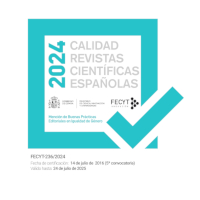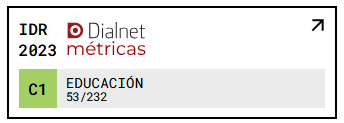The role of the teacher and the school in child protection. Casedetection and reporting in child protective services in La Rioja
DOI:
https://doi.org/10.18172/con.641Keywords:
Child abuse, detection, reporting, education systemAbstract
Currently one of the issues most frequently discussed in the professional field of child protection is the need to establish working systems that enable coordination between the different resources and institutions and between different disciplines who work around the family and children. The education system is an essential part of system resources that work with victims of child abuse. But there are many difficulties and reluctance that present the education professionals (teachers, professors, staff) to detect these situations and get involved in their resolution. This article aims to raise awareness among professionals with the triple objective of justifying its role in addressing the problem, to overcome some of the above difficulties and report on the notification procedure in the Comunidad Autónoma de La Rioja.Downloads
References
Ammerman, R. T. (1990). Etiological models of child maltreatment. A behavioral perspective. Behavior Modification, 14, 230-254.
Armenta, M. y Romero J. (2008). Consecuencias de la violencia familiar experimentada directa e indirectamente en niños: Depresión, ansiedad, conducta antisocial y ejecución académica. Revista Mexicana de Psicología, 2, 237-248.
Baginsky, M. y Hodgkinson, K. (1999). Child protection training in initial teacher training: A survey of provision in institutions of higher education. Educational Research Volume, 41, 173-181.
Banyard, V. L., Williams L. M. y Siegel, J.A. (2001). The long-term mental health consequences of child sexual abuse: An exploratory study of the impact of multiple traumas in a sample of women. Journal of Traumatic Stress, 14, 697-715.
Bernard, B. (1991). Fostering resiliency in kids: Protective factors in the family, school and community. Portland, OR: Western Regional Center for Drug-Free Schools and Comunities.
Brown G. R. y Anderson, B. (1991). Psychiatric morbidity in adult inpatients with childhood histories of sexual and physical abuse. American Journal of Psychiatry, 148, 55-61.
Cantón, J. y Cortés, M. R. (1997). Malos tratos y abuso sexual infantil. México: Siglo XXI.
Cantón, J. y Cantón-Cortés, D. (2007). Abuso sexual infantil. En E. Fernández de Haro, F. Justicia, M. C. Pichardo (Eds.), Enciclopedia de psicología evolutiva y de la educación (pp. 401-422). Madrid: Aljibe.
Cawson, P., Wattam, C., Brooker, S. y Kelly G. (2000). Child Maltreatment in the UK: A study of the prevalence of child abuse and neglect. London: National Society for Prevention of Cruelty to Children.
Cerezo, M. A. y Frías, D. (1994). Emotional and cognitive adjustment in abused children. Child Abuse & Neglect, 18, 923-932.
Cicchetti, D. y Toth, S. (2003). Child maltreatment: Past, present, and future perspectives. En R. Weissberg, H. Walberg, M. O’Brien y C. Kuster, (Eds.), Long-term trends in the well-being of children and youth: Issues in children's and families lives (pp. 181-205). Child Welfare League of America, Washington, DC.
Cicchetti, D. y Toth, S. (2005). Child maltreatment, Annual Review of Clinical Psychology 1, 409-438.
Consejería de Servicios Sociales, Gobierno de La Rioja (2003). Detección, notificación y registro de casos de Maltrato Infantil. Desde los Servicios Educativos.
Consejería de Servicios Sociales, Gobierno de La Rioja. Hoja de notificación de riesgo y maltrato infantil en el ámbito escolar.
Crittenden, P. (1992). Children´s strategies for coping with adverse home environments: An interpretation using attachment theory. Child Abuse & Neglect, 16, 329-343.
Crittenden, P. y Ainsworth, M. (1989). Child maltreatment and attachment theory. En D. Cicchetti y V. Carlson (Eds.), Child maltreatment: theory and research on the causes and consequences of child abuse and neglect (pp. 432-463). New York: Cambridge University Press.
De Paúl, J. y Arruabarrena, M. I. (1996). Manual de Protección Infantil. Barcelona: Masson.
De Paúl, J. y Pérez de Albéniz, A. (2007). Familias en las que hay malos tratos. En F. López (Coord.), La escuela infantil: observatorio privilegiado de las desigualdades, (pp. 137-154). Barcelona: Graó.
Fantuzzo, J. W. (1990). Behavioral treatment of the victims of child abuse and neglect. Child Abuse & Neglect, 14, 316-339.
Fergusson, D. M. y Horwood, L. J. (2003). Resilience to childhood adversity: Results of a 21-year study. En S. S. Luthar (Ed.), Resiliency and vulnerability: Adaptation in the context of childhood adversities (pp. 130-155). Cambridge: Cambridge University Press.
Hoffman-Plotkin, D. y Twentyman, C. T. (1984). A multimodal assessment of behavioral and cognitive deficits in abused and neglected preschoolers. Child Development, 55, 794-802.
Kaufman, M. (1962). Psychiatric implications of physical abuse of children. En V. De Francis (Ed.), Protecting the battered child (pp. 17.22). Denver, CO: American Human Association.
Kazdin, A. E., Moser, J., Colbus, D. y Bell, R. (1985). Depressive symptoms among physically abused and psychiatrically disturbed children. Journal of Abnormal Psychology, 94, 298-307.
Kelly, J. A. (1983). Treating child abusive families: Intervention based on skills-training principles. New York: Plenum.
Klimes-Dougan, B. y Kistner, J. (1990). Physically abused preschoolers´ responses to peers´ distress. Developmental Psychology, 26, 599-602.
Ley Orgánica 1/1996, de 15 de enero, de Protección Jurídica del Menor (BOE número 15, miércoles 17 de enero de 1996).
Ley Orgánica 2/2006, de 3 de mayo, de Educación (BOE número 106, jueves 4 de mayo de 2006).
Luthar, S. y Cicchetti, D. (2000). The construct of resilience: Implications for interventions and social policies. Development and Psychopatholgy, 12, 857-885.
Luthar, S. y Zigler, E. (1991). Vulnerability and competente: A review of research on resilience in childhood. American Journal of Orthopsychiatry, 61, 6-22.
Main, M. y George, C. (1985). Responses of abused and disadvantaged toddlers to distress in agemates: A study in the day-care setting. Developmental Psychology, 21, 407-412.
Martínez-Roig, A. y De Paúl, J. (1993). Maltrato y abandono a la infancia. Barcelona: Martínez Roca.
Melnick, B. y Hurley, J. R. (1969). Distinctive personality attributes of child abusing mothers. Journal of Consulting and Clinical Psychology, 33, 346-749.
Morales, J. M. y Costa, M. (1997). Tendencias actuales en la investigación del maltrato infantil. En J. Casado, J. A. Díaz y C. Martínez (Eds.), Niños maltratados (pp. 309-323). Madrid: Díaz de Santos.
Myers, J., Berliner, L., Briere, J., Hendrix, C., Jenny, C. y Reid, T. (2002). The APSAC handbook on child maltreatment (2nd ed.). Thousand Oaks, CA: Sage Publications, Inc.
Overstreet, S., Dempsey, M., Graham, D. y Moely, B. (1999). Availability of family support as a moderatos of exposure to community violence. Journal of Clinical Child Psychology, 28, 151-159.
Pereda, N., Guilera, G., Forns, M. y Gómez-Benito, J. (2009). The prevalence of child sexual abuse in community and student samples: A meta-analysis. Clinical Psychology Review, 29, 328-338.
Rak, C. y Paterson, L. (1996). Promoting resilience in at-risk children. Journal of Counseling & Development, 74, 368-373.
Rossato, C. (2009). Child protection training in sportrelated degrees and initial teacher training for physical education: An audit. Child Abuse Review, 18, 81-93.
Saldaña, D., Jiménez, J. y Oliva, A. (1995). El maltrato infantil en España: Un estudio a través de los expedientes de menores. Infancia y Aprendizaje, 71, 59-68.
Sanders, R., Colton, M. y Roberts, S. (1999). Child abuse fatalities and causes of extreme concern: Lessons from reviews. Child Abuse & Neglect, 23, 257-268.
Shonk, S.M. y Cicchetti, D. (2001). Maltreatment, competency deficits, and risk for academic and behavioral maladjustment, Developmental Psychology, 37, 3-17.
Spinetta, J. J. y Rigler, D. (1972). The child abusing parent: A psychological review. Psychological Bulletin, 77, 296-304.
Staller, K. y Faller, K. (2010). Child sexual abuse: Legal burdens and scientific methods. New York, NY, US: Columbia University Press.
Stone, S. (2007). Child maltreatment, out-of-home placement and academic vulnerability: A fifteen-year review of evidence and future directions. Children and Youth Services Review, 29, 139-161.
Straker, G. y Jacobson, R. S. (1981). Aggression, emotional maladjustment and empathy in the abused child. Development and Psychopathology, 17, 762-765.
Toth, S. L., Manly, J. y Cicchetti, D. (1992). Child maltreatment and vulnerability to depression, Development and Psychopathology, 4, 97-112.
U.S. Department of Health and Human Services, Administration on Children, Youth and Families. (2007). Child Maltreatment 2005. Washington, DC: U.S. Government Printing Office.
Wolfe, D. A. (1987). Child abuse: Implications for child development and psychopathology. London: Sage.
Zigler, E. y Hall, N. W. (1989). Child abuse in America: Past, present and future. En D. Cicchetti y V. Carlson (Eds.), Child maltreatment: Theory and research on the causes and consequences of child abuse and neglect (pp. 38-75). Cambridge: Cambridge University Press.
Downloads
Published
How to Cite
Issue
Section
License
The authors retain copyright of articles and authorize Contextos Educativos. Revista de Educación the first publication. They are free to share and redistribute the article without obtaining permission from the publisher as long as they give appropriate credit to the editor and the journal.
Self-archiving is allowed too. In fact, it is recommendable to deposit a PDF version of the paper in academic and/or institutional repositories.












